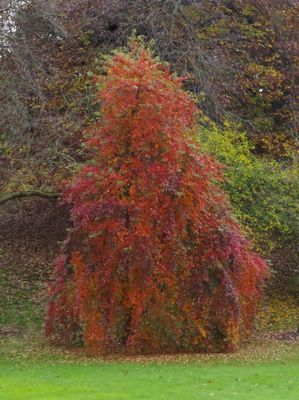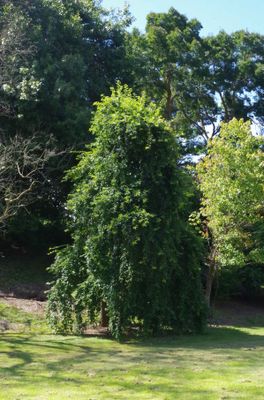


Nyssa sylvatica, weeping form
Nyssa
Nyssa sylvatica's genus name, Nyssa, refers to a Greek water nymph; the species epithet sylvatica refers to its woodland habitat. The species' common name, tupelo, is of Native American origin, coming from the Creek words ito "tree" and opilwa "swamp"; it was in use by the mid-18th century.
Nyssa sylvatica grows to 20–25 m tall, with a trunk diameter of 0.5 - 1 m. Trees of Nyssa sylvatica weeping form typically have a straight trunk with the pendulous branches. The bark is dark gray and flaky when young, but it becomes furrowed with age. The leaves of this species are variable in size and shape. They can be oval, elliptical, or obovate, and 5–12 cm (2–4.5 in) long. They have lustrous upper surfaces, with entire, often wavy margins. The foliage turns purple in autumn, eventually becoming an intense bright scarlet. The flowers are very small, in greenish-white in clusters at the top of a long stalk and a rich source or nectar for bees. They are often dioecious so a male and female tree in proximity is required to set seed, however, many trees are also polygamo-dioecious, which means they have both male and female flowers on the same tree. The fruit is a black-blue, ovoid stone fruit, about 10 mm long with a thin, oily, bitter-to-sour tasting flesh and very popular with small bird species. There are from one to three fruits together on a long slender stalk. The honey made from Nyssa is highly sought after for its sweet, buttery taste. The bark was once used medicinally as an emetic and as a cure for worms while it's strong, shock resistant wood was commonly used to make gunstocks, plows, and hammers.
96.00 Location C4 Latitude; -38.402088490000 Longitude; 146.052447690000

